How to create a compelling dentist resume in 2022?
This resume guide for dentists provides all the key information needed to create an effective dental resume. Topics discussed include formatting, writing a summary, choosing skills, and creating work experience and education sections on a dentist’s resume.
Becoming a dentist is no small feat. While your years of training and education should certainly earn you a top-paying position, you will need a compelling resume to help get your foot in the door at the practice of your choice.
In this guide, we will be taking you through the necessary steps for optimizing your resume for a job in dentistry. By reading this guide, you will learn:
- The types of resume formats to choose from and which best fits a dentist resume
- How to write a resume summary tailored for dentistry
- The best dentistry skills to include on your resume
- How to optimize your work experience section to show off your accomplishments
- How to list your education correctly
1. Use the reverse-chronological format to show off your experience
The general rule of thumb when it comes to any sort of healthcare resume is to use the reverse-chronological resume format when possible.
Reverse-chronological resumes place the utmost focus on work experience, making this section the largest and most central element in the document. This type of resume will list your most recent position first and work backward from there.
This format is ideal for dentistry because it gives candidates the best opportunity to showcase their relevant work experience and demonstrate their abilities through key responsibilities and achievements.
However, there are scenarios in which an alternative resume format may be required:
- Curriculum Vitae (CV): A CV is a long-form and multi-page resume typically used for job applications in scientific or academic fields. It allows for professionals to include far more information than a one-page resume, such as awards, publications, or research.
- Functional: Functional resumes take the emphasis off of work experience and place it instead on skills, education, or unpaid experience. This type of resume is well suited for recent graduates with limited experience or candidates with gaps in their resumes.
- Hybrid: A hybrid resume will combine elements of both the functional and reverse-chronological formats. This is a more custom format that allows candidates with some relevant work experience to showcase more than one section. The hybrid format works well for people who are changing careers or industries.
2. Write a resume summary to clearly outline your qualifications
A resume summary serves an important purpose – introducing your resume to a hiring manager and whetting their appetite with just enough persuasive and relevant information to make them want to know more about you as a professional.
Let’s look at an example of an incorrect resume summary for a dentist and discuss how to correct it:
Incorrect dentist resume summary example
"Dental professional with 6 years of experience working in an office with new and recurring patients. Carried out a full range of dental work and experienced a high level of customer satisfaction throughout time in previous positions."
Why is this incorrect? This dentist's resume summary is on the right track but is missing a few key elements that would make it a lot stronger. First and foremost, the applicant should provide more specific details regarding the range of dental work experience they have and provide greater context around the patient satisfaction point.
Corrected dentist resume summary example
"Enthusiastic and compassionate dental professional with over 6 years of experience working in dental care and administration. Specialized in dental prosthetics and related dental services. Received more than 50 positive reviews on Yelp, increasing the dental practice’s score from 3.5 to 5 stars."
Why is this correct? In this corrected example, the applicant makes it much more clear what areas of dentistry they specialize in (dental prosthetics). Additionally, they offer quantifiable information regarding their increased patient satisfaction levels through the improved Yelp rating example.
3. Choose skills that highlight a wide range of abilities
Working in dentistry requires you to have people skills that are equally as impressive as your dental skills. One wrong interaction with a customer can negatively impact a practice, no matter how good the quality of the work was.
With this in mind, it is important to highlight both hard (technical) and soft (interpersonal) skills on your resume. This will show employers that you are more than just a talented dentist – you are also a capable communicator who can satisfy a patient’s emotional needs as well.
Here are 10 hard and 10 soft skills to include on a dental resume:
Best hard skills to put on your dentist resume
- X-Rays
- Fluoride Treatment
- Basic Dental Care (Fillings, Cleanings, Cancer Screenings)
- Visual Assessments
- Laser Whitening
- Specialized Services (Prosthetics, Cosmetic Procedures, etc.)
- Crowns and Bridges
- Veneers
- Preventative Dentistry
- Oral Surgery (Root Canals, Wisdom Teeth Removals, etc.)
Best soft skills for a dentist resume
- Compassion
- Empathy
- Active Listening
- Verbal Communication
- Non-Verbal Communication
- Attention to Detail
- Dexterity
- Team Work
- Leadership
- Time Management
4. List important accomplishments in your work experience section
When writing your work experience section, it is essential that your job descriptions do more than just plainly list your responsibilities.
You should use these descriptions as an opportunity to play up your biggest responsibilities and showcase any accomplishments you achieved during your time in the position.
Example work experience section for a dentist resume
Dentist | Cleaner Smiles Dental
Albuquerque, NM | May 2018 to June 2021
- Provided thorough and detailed assessments for patients, including full cancer and oral disease screenings and preventative care.
- Created a new low-cost patient onboarding program to provide basic dental care to underprivileged communities, resulting in a 10% reduction in local oral disease prevalence.
- Managed a client database of over 15,000 patients across a network of 10 dental offices.
5. List your education correctly and succinctly
For a dental resume, you will need to list both your education and any additional certifications you may have. When listing your education, you want to keep it brief and to the point.
If you are a recent graduate, including your GPA may be relevant – however, if you are more than 5 years out of college, we recommend omitting the GPA information.
Here is an example of a well-formatted and succinct education section:
Education
- Doctor of Dental Surgery (DDS)
- Howard University College of Dentistry | Washington, D.C.
- Graduated 2015 Summa Cum Laude
How to list certifications?
If you do have certifications you would like to include, make sure they are specific and relevant to the job you are applying for. For instance, if you are a certified provider for Invisalign, this is good information to include.
If you have 3 or fewer certifications, you can likely include them within your education section. Otherwise, you should create a dedicated section to keep your resume organized and easy to read.

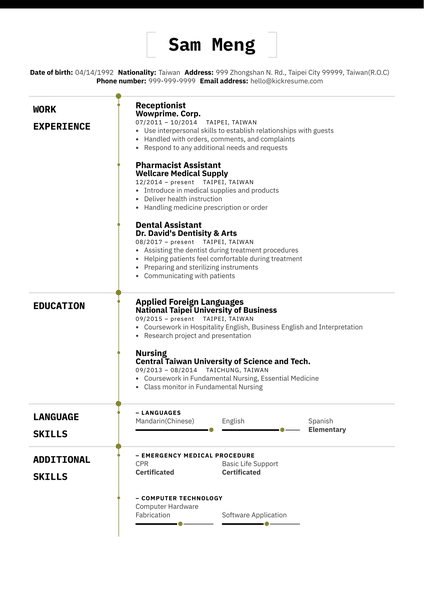
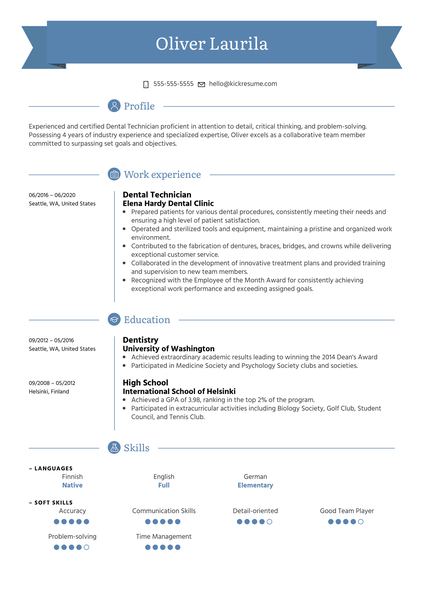

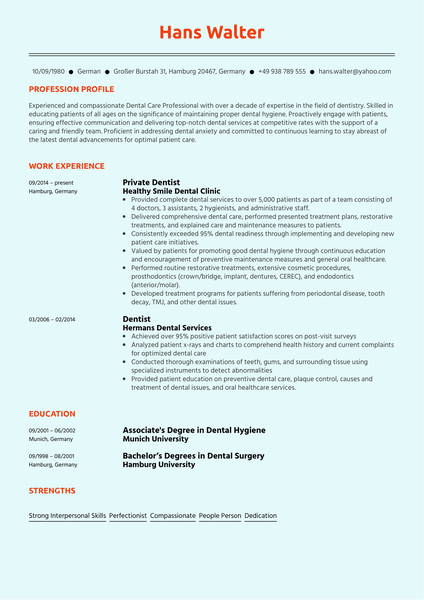

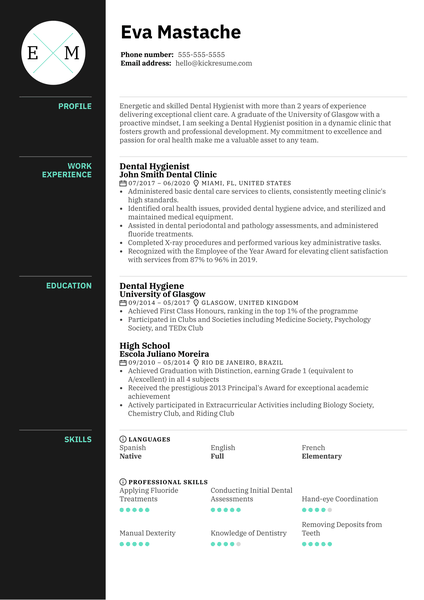

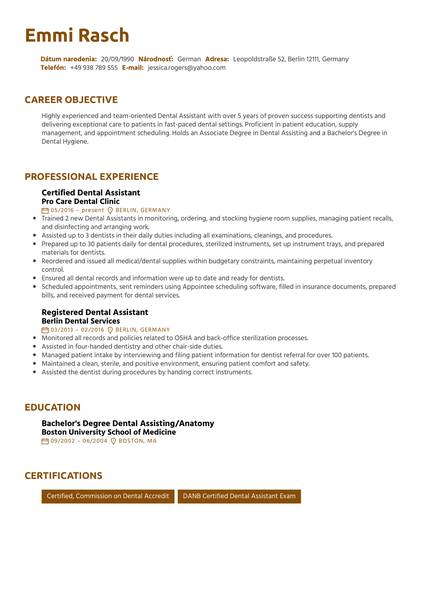

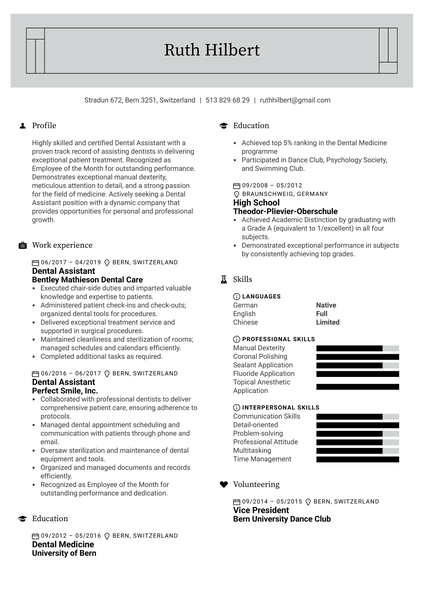
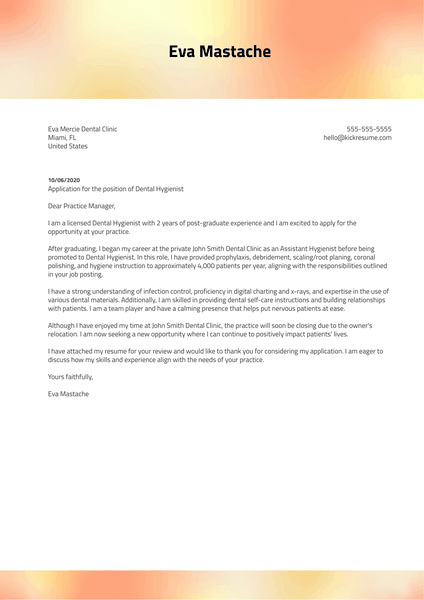
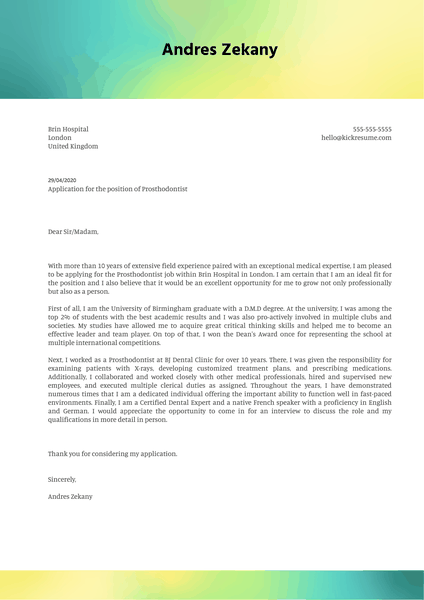
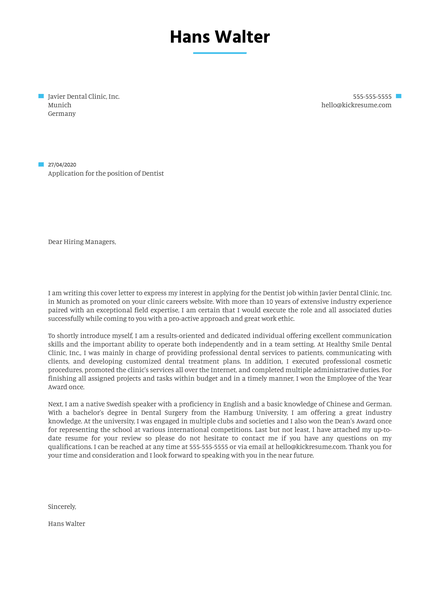
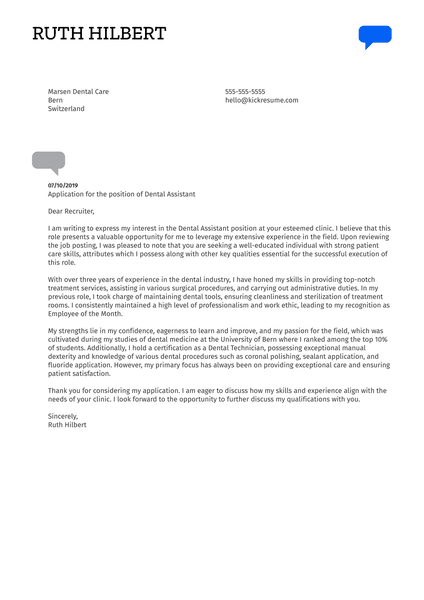
![How to Write a Professional Resume Summary? [+Examples]](https://d2xe0iugdha6pz.cloudfront.net/article-small-images/i-Profile.svg)
![How to Put Your Education on a Resume? [+Examples]](https://d2xe0iugdha6pz.cloudfront.net/article-small-images/i-Collage-Universities.svg)
![How to Describe Your Work Experience on a Resume? [+Examples]](https://d2xe0iugdha6pz.cloudfront.net/article-small-images/Experience.svg)


